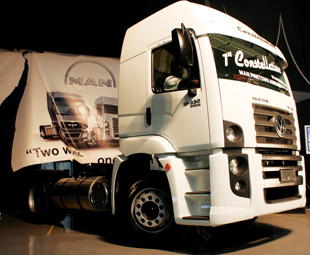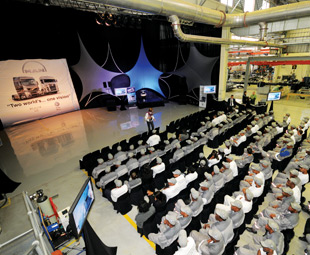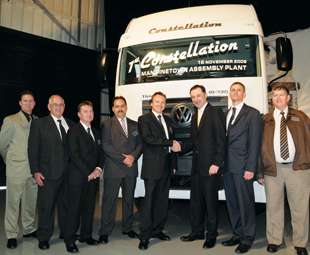MAN-sized moment

As we all know, MAN and Volkswagen recently got hitched. CHARLEEN CLARKE attends the birth of their first baby…
When trucks break down, people get grumpy. Seriously grumpy, in fact. And that’s precisely what has transpired on a SAA flight to Durban. The truck in question is the one that transports the food for the passengers. According to the cheerful pilot (it’s funny how they are always cheerful, especially when they know they’re annoying passengers), the catering truck has met an early demise, which is the reason why we’re taking off 45 minutes late.
I’m not too fussed; I’m not on a tight schedule. The same clearly cannot be said of the man squeezed into the seat next to me. “Damned trucks! Why do they always have to break down? If they aren’t delaying planes, they are causing havoc on our roads…” he splutters, wheezing noisily as he complains. He seems to be in similar nick to the truck that has just expired; I fervently hope that he isn’t about to meet the same fate.
I suggest to my fellow passenger that SAA should have taken off sans the nosh. After all, SAA’s food is seldom a gourmet’s delight… My suggestion is not well received. “Are you insane? I paid for that food, and I am absolutely starving,” says Mr Podge. I can see tangible evidence that he hasn’t been starving for years, but I keep this thought to myself and bury my head in a magazine instead…
Two hours later, I’m at MAN’s Pinetown assembly plant and I cannot help but think of the bulbous, podgy man. It’s not that I am surrounded by grumpy people. Au contraire; everyone is beaming and in a celebratory mood. The very first Volkswagen, a Constellation 19.320, has just rolled off the assembly line… it’s definitely cause for celebration.
But I keep thinking about the implications of something going wrong. This was a world first; the South African plant is a manufacturing guinea pig. This is the first time that both MAN and Volkswagen vehicles are being assembled on one integrated production line (if it’s a success, the concept will be rolled out elsewhere in the world). However, had the MAN team not pieced together that Constellation properly, it would almost certainly break down at some stage, leaving some poor operator in the lurch and who knows how many people exceptionally grumpy.
In fairness, given the resources allocated to the project, however, it was unlikely that things would ever go wrong. In a tangible sign of commitment, a veritable army of VIPs has converged on Pinetown for the celebration. MAN Truck & Bus Africa CEO, Thomas Hemmerich, is  there – of course. But he has also been joined by Dr Frank Hiller, executive board member for marketing, sales and services at MAN Nutzfahrzeuge; Marcos Forgioni, sales and marketing director: international markets at MAN Latin America (previously known as VW do Brazil), Laercio Molina, executive manager at MAN Latin America, and a host of other senior members of the management teams from both Germany and Brazil.
there – of course. But he has also been joined by Dr Frank Hiller, executive board member for marketing, sales and services at MAN Nutzfahrzeuge; Marcos Forgioni, sales and marketing director: international markets at MAN Latin America (previously known as VW do Brazil), Laercio Molina, executive manager at MAN Latin America, and a host of other senior members of the management teams from both Germany and Brazil.
Of course, the commitment of senior management wasn’t enough to guarantee success, and many months of hard work preceded the assembly of the first truck. According to Marc Michel, plant manager at MAN Pinetown, since the announcement that MAN SE and Volkswagen’s commercial vehicle operation would be integrated in December 2008, a great deal of planning and preparation preceded the birth of the company’s first Volkswagen baby.
TRUCK IN A BOX
Much of the work was real pioneering stuff. “As the leading Completely Knocked Down or CKD assembly operation in the MAN Group we were tasked with pioneering our CKD ‘Truck in a Box’ assembly process for the assembly of our new combined range of commercial vehicles. This is a huge honour and is also a monumentally important task, as this process will eventually be adopted in other key emerging markets around the world,” says Michel. The Pinetown plant’s “Truck in a Box” assembly concept is exactly as it sounds: the truck literally arrives in bits and pieces in a box. This is completely different to the process that was used to assemble the Volkswagen trucks in the old Uitenhage plant, where the bits and pieces came from a parts warehouse.
In order to get the whole system to run smoothly, Michel and his team made a number of significant changes. “Our first task was to improve and streamline efficiency at the MAN Pinetown assembly plant. So we took the decision to unify our line feed strategy and assemble all vehicles on the same assembly line. In the past, the plant had two separate production lines, where line A was used to produce various MAN Trucknology and CLA truck ranges, while line B was used to assemble MAN Lion’s Explorer bus chassis,” he explains.
So now there is one assembly line that produces all the vehicles – from MAN trucks and buses through to Volkswagen products. A total of 140 people work in the plant, and seven vehicles are currently produced each and every day. This will increase to 13 units a day in 2010, but the team can assemble more vehicles if required: the maximum capacity of the facility is 18 units a day.
Naturally, a considerable amount of training was required: staff members from Volkswagen in Uitenhage have already helped train MAN staff, and MAN will shortly be sending operators to MAN Latin America’s production facility in Resende, Brazil, for additional training.
Hemmerich is clearly delighted with the transformation of the plant. “The world is watching us closely and I have every confidence that we will make a great success of this initiative,” he comments.
MAN Latin America’s Marcos Forgioni is also upbeat, but for a different reason: he tells FOCUS that the integration has been fabulously successful. “From the beginning, we were treated as people who knew trucks. It has been an outstanding period for all of us. We feel happy to be among truck people,” he comments.
So the integration has been smooth and relatively painless. The end result is the company now has a committed and happy team at all levels, and also a wide and all-embracing product range. Not surprisingly, given this scenario, Hemmerich’s goals for this continent are lofty. “Long term, our aim is to sell between 6 000 and 8 000 units per year into the entire African region,” he says.
Hiller is equally optimistic. “The production plant in Resende, Brazil, which now operates under the banner of MAN Latin America, has become an integral part of MAN SE’s plans to become one of the world’s leading truck and bus groups. The vehicles produced there, which include heavy trucks, buses and coaches, are market leaders in Brazil. This status will help to pave the way for MAN to take the lead in this market, as well as in other BRIC countries, as MAN takes the lead in the sales and after-sales process globally through dual-branded dealerships,” he says.
The Resende plant will be building MAN trucks soon, specifically TGS/TGX derivatives.
There are substantial benefits on the African continent too. MAN’s tentacles extend well into the market, and it has a well-established and highly respected dealer network. Volkswagen is bringing a great deal to the party too; Johan Cloete (ex-Volkswagen and now MAN board member) has already introduced the MAN team to the existing Volkswagen dealer in Kenya, and he says that the potential there is nothing short of huge.
Mozambique is looking good. Volkswagen recently signed a 100-bus order there and the team is working towards securing an order for an additional 200 units.
Business is also booming in Angola and Forgioni says the company has sold more than 4 000 Volkswagens in that market, largely Worker derivatives. The Worker isn’t sold in South Africa, because no right-hand drive models are available.
Of course, given the global recession, the MAN/VW pairing could not have come at a better time. “The world is slowly emerging from one of the most difficult and challenging economic times in history, and it will take some time before the developed markets recover to levels last seen in 2007. This is why a global emerging market strategy is so important for us and why we have been working so hard to make MAN a truly international company with a large global reach,” notes Hiller.
Hemmerich is confident that the local company will make a massive contribution to this goal. “With the addition of the vehicles already supplied into Africa by MAN Latin America, we aim to double our sales volume. Our target is therefore to substantially increase our annual sales into Africa, which we feel is very achievable given the potential that the African market holds but is also obviously dependent on further developments in the world economy.
“This growth will largely be driven by the heavy truck segment which, following the merger, MAN Truck & Bus Africa is well positioned to service, as we now have a more holistic product offering from which to grow market share, especially in the 4×2 and freight carrier sectors,” he maintains.
Clearly, everything on the MAN horizon looks just dandy. However Hemmerich is realistic, and he says that the company certainly isn’t planning to rest on its laurels. “We know that the European trucks are on the same level from a technology perspective. It isn’t enough to deliver a good product; we have to deliver exceptional service too.”
Bearing this in mind, the company is introducing a new 10-point service offering (more about this in a future issue of FOCUS), which will see the company’s service levels rise to new heights. Hemmerich is also eyeing a FOCUS on Excellence nomination for the Vehicle Distributor with the Best Service Support in 2010.
So, MAN is sitting pretty right now. It anticipates a growth in market share. The plant is assembling both brands to world-class quality standards, and service levels are set to improve.
The next time I board an airline, I hope that the catering truck is a MAN…
Published by
Focus on Transport
focusmagsa



